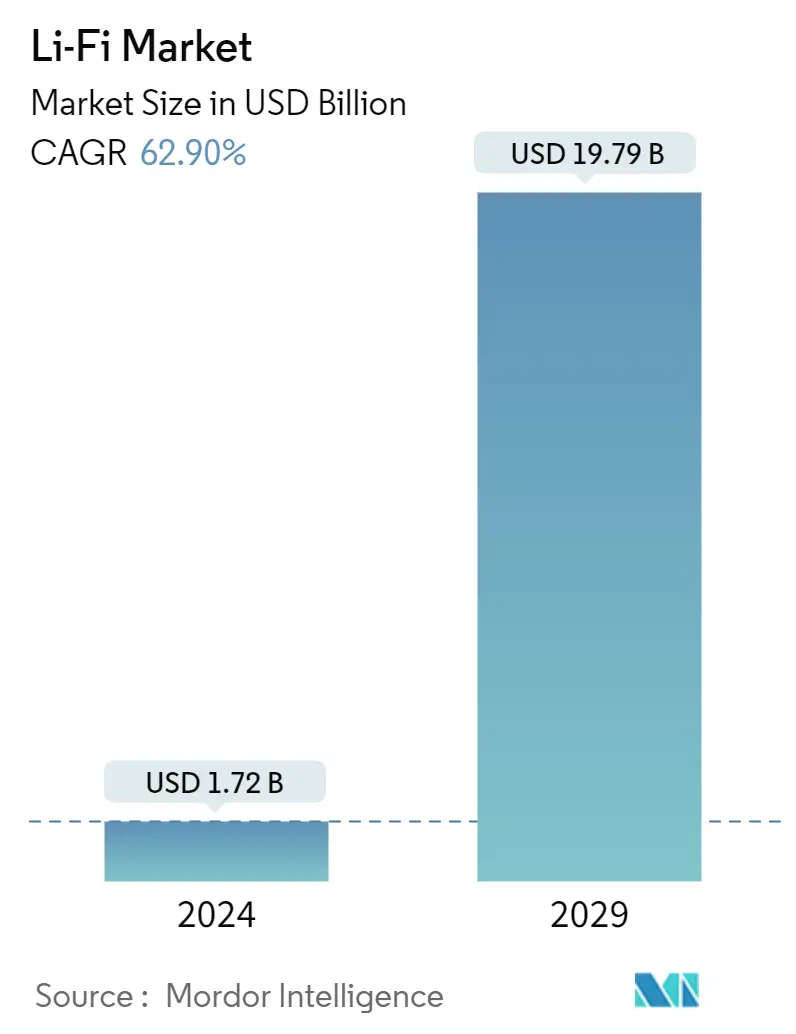Market Size of Li-Fi Industry

| Study Period | 2019 - 2029 |
| Market Size (2024) | USD 1.72 Billion |
| Market Size (2029) | USD 19.79 Billion |
| CAGR (2024 - 2029) | 62.90 % |
| Fastest Growing Market | Asia Pacific |
| Largest Market | North America |
Major Players_Market.webp)
*Disclaimer: Major Players sorted in no particular order |
Need a report that reflects how COVID-19 has impacted this market and its growth?
Li-Fi Market Analysis
The Li-Fi Market size is estimated at USD 1.72 billion in 2024, and is expected to reach USD 19.79 billion by 2029, growing at a CAGR of 62.90% during the forecast period (2024-2029).
Light Fidelity (Li-Fi) is a wireless optical networking technology that transmits data through light-emitting diodes (LEDs). A new wireless connection uses light sources instead of microwaves to transmit data. The technology works by modulating the light emitted by LEDs to transmit data, which is then received by a sensor that interprets the modulations as data.
- Li-Fi can achieve data transmission speeds that are about 100 times faster than those achievable by Wi-Fi. Light travels extremely fast, allowing almost instantaneous connections and faster data transmissions. Li-Fi uses highly efficient LED bulbs, resulting in lower energy consumption than other technologies. This can lead to cost savings in terms of energy usage.
- Li-Fi also offers military-grade security by default. Since light does not penetrate walls or leak through materials, it can be contained within a space, eliminating the ability for man-in-the-middle attacks outside the coverage area. This ensures privacy and security for users- li-fi experiences less interference compared to other wireless communication technologies. Li-Fi uses light frequencies, which are less prone to interference from other devices or signals. Li-Fi can work effectively in dense regions with congested or limited Wi-Fi signals. This makes it a suitable technology for environments with a high concentration of devices or users.
- Li-Fi is a wireless communication technology that uses the infrared and visible light spectrum for high-speed data communication. Li-Fi technology transmits data at a very high speed and is capable of delivering 224 GB of data per second. The emergence of LED as a viable solution has further simplified the use of LI-Fi, enabling high-speed networks. LED bulbs are semiconductor devices in which the current can be modulated to affect different intensities of light. A photo-detector is used on devices to capture the LED light and demodulate the data encoded in it. The system works similarly to how infrared communication works between devices, such as a remote control and a TV or a remote-controlled car. Due to the high intensities of LED lights, they can be used to send high-speed data across the light spectrum to any device with a photo-detector. The LED lights work as normal, and the modulation process is not visible to the human eye.
- LEDs are energy efficient and may serve for a longer period, which makes them more cost-effective for use in indoor and outdoor lighting. Smart lighting and color-changing capabilities that mobile devices can control have added to the demand from commercial spaces across the region. According to the US Department of Energy, LED lights typically use about 25% to 80% less energy than traditional incandescent bulbs. LEDs are also directional light sources, which means they can emit light in a specific direction, allowing them to use light and energy more efficiently.
- Adopting the Li-Fi solution has certain constraints, such as the need for more technology awareness, restricted range, and connectivity. In addition, LiFi has a limited coverage area compared to traditional wireless technologies, as the signal is confined to the line of sight between the transmitter and receiver. This means LiFi signals cannot penetrate walls or other physical obstacles, limiting their range and coverage. In contrast, Wi-Fi and cellular networks offer much broader coverage areas and can transmit data over longer distances.
- The COVID-19 outbreak and lockdown restrictions worldwide severely affected industrial activities. The effects of the lockdown include labor shortages, disruptions in the supply chain, lack of availability of raw materials utilized in the manufacturing process, fluctuating prices that could force the production of the final product to increase and go beyond budget, shipping problems, etc. The COVID-19 pandemic expedited and re-emphasized the requirement for automation worldwide. The adoption of bots for process discovery, intelligent data capture, and cloud-native bots across the automation sector is growing.
